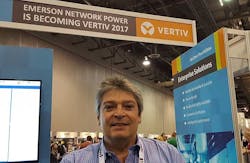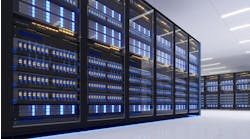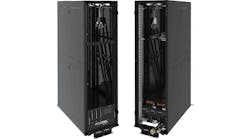LAS VEGAS – As it relaunches as a private company with a new brand, Vertiv confronts a changing landscape in its core niche of data center power and cooling products. Vertiv is the new name for Emerson Network Power, which was acquired by the private equity firm Platinum Equity Group in a $4 billion transaction. The deal closed Dec. 1, and last week’s Gartner Data Center Conference provided a first look at the new Vertiv.
Like all parts of the data center industry, the power and cooling sector is adapting to the growth of cloud computing, which is concentrating IT workloads in hyperscale facilities. Vertiv executives say the new company is better positioned to respond to the shift to web-scale infrastructure.
“There’s lots of great things about being a private company, and that’s exciting,” said Enzo Greco, Vice President and General Manager, Software for Vertiv. “We’ve seen how quickly the market is changing. One of the biggest advantages is that it allows us to invest on a long-term basis, rather than focusing on a quarterly return. This will let us look at the business holistically and strategically.”
Emerson Electric created Emerson Network Power (ENP) in 2000, forming a data center unit around its powerful Liebert brand of computer room air conditioner (CRAC) units, which supply perimeter cooling for raised-floor data centers. The ENP business grew through M&A, including the acquisition of software firms Avocent and Aperture and UK-based Chloride, which specialized in uninterruptible power supply (UPS) units.
One of the challenges facing Emerson and its competitors is the emergence of cloud computing and its impact on infrastructure. Hyperscale players build large facilities focused on energy efficiency, including reduced reliance on mechanical air conditioning. In these cloud campuses, CRACs and raised floors have mostly been replaced by slab floors and cooling systems using direct or indirect fresh air cooling.
‘A Cornerstone in Our Portfolio’
In June 2015, Emerson announced plans to spin off Network Power as a separate public company through an IPO. Suitors emerged, and in August Emerson announced that it would sell ENP to Platinum Equity, with Emerson retaining a minority stake in the business. Platinum has been interested in the data center industry for years, dating to its 2004 bid for assets of Cable & Wireless.
“This is an important investment in a business that will be a cornerstone in our portfolio,” said Platinum Chairman and CEO Tom Gores in announcing the deal. “It plays to our core strengths. In addition to our capital resources, we will deploy our global operations skills to build on the foundation Emerson created and take this business to another level.”
“It’s a fresh start for a business that already has so much going for it,” said Johnson. “As an independent company, Vertiv will operate with great freedom to make business strategy and investment decisions, move more quickly like a startup, and focus on innovative solutions for our customers, including those in the growing cloud computing, mobile and IoT networks.”
Opportunities in IoT, Edge Computing
At Gartner, Greco cited the Internet of Things (IoT) as a particularly promising opportunity.
“The data center has been doing IoT for a long time,” said Greco, whose background includes stints at AT&T Bell Labs and IBM in addition to entrepreneurial ventures. “The more data these disparate sensors and devices offer up, the better the data center can operate.
The Internet of Things is exactly the same thing,” he said. “We know how to do IoT very well. We just need to package it up. The opportunity for us is in standardization, and helping organize that.”[clickToTweet tweet=”Enzo Greco of Vertiv: The data center has been doing IoT for a long time. We know how to do IoT very well. ” quote=”Enzo Greco of Vertiv: The data center has been doing IoT for a long time. We know how to do IoT very well. “]
Greco also sees opportunities for Vertiv in edge computing.
“With edge computing, you’re trying to move compute, access and storage as close to the end user as possible,” said Greco, who said edge requirements could be encapsulated in an “intelligent rack” with integrated power, located close to the user, often outside a traditional data center.
“For some customers, it’s a smaller data center,” he said. “There will be different form factors for power and cooling. A rooftop could be ideal in many scenarios, others might require a rack for smaller spaces.”
A Market in Transition
Vertiv’s core market of data center power and cooling is in transition. New research from IHS Markit finds that the data center cooling market declined slightly in 2015, but will likely return to single digit growth in 2016. The shift toward cloud is giving clout to a more concentrated group of cloud and service provider buyers, according to Sarah McElroy, Senior Research Analyst, Cloud and Data Centers at IHS.
“Because colocation and cloud companies are absorbing parts of what was once the enterprise data center market, they account for an increasing share of the total data center market and now hold a lot of negotiating power when purchasing data center infrastructure,” writes McElroy. “They can often negotiate lower pricing on things like cooling equipment, negatively affecting revenue (for vendors).”
Although the enterprise data center is changing, Greco says there are some interesting business opportunities with service providers. That’s especially true in software, as colocation providers look to add services. “This is a rapidly changing part of the market,” he said. “What’s happening is that some colos are starting to add much more value.”
Opportunities for Vertiv include equipping providers in “data center as a business” services such as tracking third-party equipment, security, and managing performance against SLAs (service level agreements). For colo customers, services could include visualizations through portals, analytics and remote management.
Looking Beyond the Data Center
Greco thinks Vertiv can find additional opportunities by looking beyond its traditional verticals.
“As part of Emerson, we were the data center division,” said Greco. “That was our focus. There are many similar markets that can benefit, if we put it all together. There are many adjacent markets that have qualities similar to a data center. They may need precision cooling and quality power and have devices that need orchestration. There are many industries where we can quickly extend our software, hardware and services.”
Like its predecessor Emerson Network Power, Vertiv will likely look to expand through acquisitions, according to Platinum Equity Partner Jacob Kotzubei.
“We will support Vertiv’s growth and product innovation every step of the way, both organically and through prospective add-on acquisitions,” said Kotzubei.






